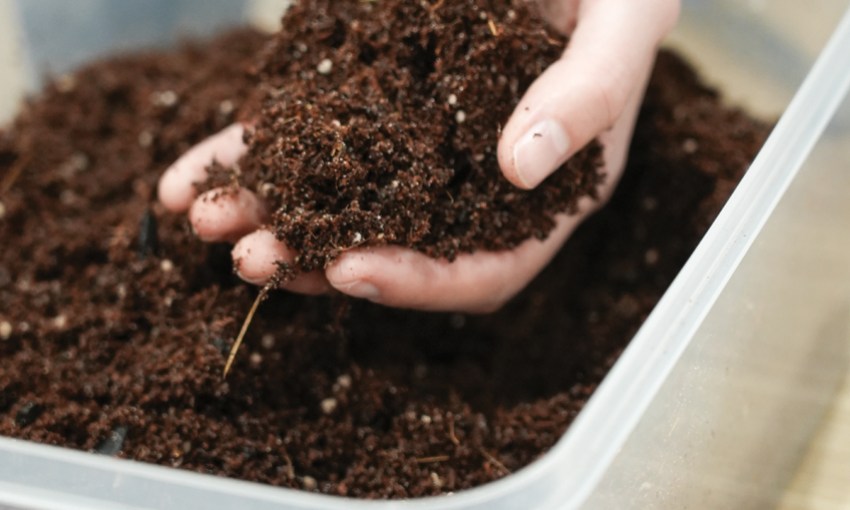Following an all-consuming passion for everything to do with terrariums, Helen Piercy has turned a backyard passion into a bricks and mortar business with the help of family, friends, and Renew Adelaide’s social and economic revival plan for the CBD.
The wide world of terrariums
Helen is a scientist who swapped her lab coat and Bunsen burner for miniature plants. Making terrariums started as a relaxing hobby during downtime from university. As she finished one and then started another, terrariums soon began to fill her mum’s kitchen table and shelves. The obvious solution was to sell them. Terrarium-laden trestle tables were set up at markets and were keenly snapped up by customers.
“Terrariums very closely replicate the earth, exhibiting many of the natural processes that occur on the planet,” says Helen.

“Inside a terrarium, the same cycles occur. These cycles work within closed terrariums (with lids), not open types. Evaporation, condensation and precipitation happen, and you can even see clouds forming, which is really cool.
“Water is constantly being recycled with little or no additional moisture needed. Then there is the carbon cycle with insects and bacteria working away releasing CO2 which is taken up during photosynthesis to help build the plants.”
Helen also adds springtail insects to her terrariums. These break down organic matter like fallen leaves, turning it into food that is ready for the green life inside.
She sees terrariums as wonderful ways to educate young and old about creating a balanced environment. From her space at Charles Street Plaza, off Rundle Mall, Helen sells finished terrariums and individual components such as glass containers and plants.
There are also popular school holiday workshops both in-store and at the South Australian Museum.
Helen loves the opportunity to share her knowledge with beginners and through events and functions including birthday parties, team building groups, even hen’s nights where everyone leaves with a mini world and loads of knowledge.

The shop would not have been possible without support from Renew Adelaide which sources flexible rent-free spaces in the CBD, connecting property owners wanting to activate their space with people looking for somewhere to trial their business concept. Helen applied, submitted her business plan and was successful in securing a lease on her Charles Street Plaza premises.
There are several important processes and elements to building and maintaining a successful terrarium. First is the container. Terrariums can be set up in vessels of any size, although bigger jars are more resilient and longer lasting. Clear glass is critical as coloured glass restricts some UV rays essential for plant growth.
Start with a layer of pebbles on the base to help separate plant roots from pooling water, allowing air spaces and reducing the risk of root rot. Next, a layer of horticultural charcoal acts as a filter, preventing mould growth.
Then comes the growing medium. Avoid potting mix which can break down into finer particles over time, clogging and restricting drainage. Also, some mixes contain fertliser; nutrients can leech out and become toxic to plants. Instead, a medium that drains well and is relatively inert provides the perfect planting bed.

Helen’s special growing mix is the result of years of tweaking ingredients to get that balance of water-holding and plant-growing just right. She uses this mix in her terrariums and at workshops, but there are plans to sell this direct to customers.
Hardscaping follows. Here is where you can release your creativity, designing a jungle space or fantasy world with the deft placement of rocks, gravel pathways, coloured stones, plus figures and decorations.
The plants come last. While there are no rules about where they should be placed, be sure to wash off any potting mix before adding the plant to the terrarium. Laying moss provides a height variation and gives perspective to the design. Keep plants at least 2cm apart to prevent overcrowding.
Long-handled tweezers are brilliant for opening soil and placing the plant. Because the terrarium environment is humid, even unrooted cuttings can be put in situ and are likely to establish.
Once finished, pop on the lid and find a place indoors that is bright but doesn’t receive direct light. The sun’s rays magnify through the glass, overheating and burning plants. Well planned terrariums can be productive for more than 60 years. Overwatering is the main reason most terrariums fail, so only add moisture if you are sure the ecosystem needs it.
To tap into Helen’s Mini Worlds, drop into her CBD store or visit helensminiworlds.com where you can order products and find out about upcoming workshops.
Helen’s top terrarium plants
Tropical plants: These work well as they are ideally suited to a jungle environment.
Fittonia: Native to South American rainforests, these are a perfect accent plant, bearing leaves with highlighted veins across a range of colours from white to deep pink. Helen’s favourite.
Aluminium plant: Named because of its distinctive silver leaf patterns, these are easy to grow, undemanding and well suited to a contained garden.
Rabbit’s foot fern: A resilient fern that won’t get out of hand. It produces furry rhizomes that crawl across the ground absorbing moisture and nutrients along the way.
Calathea: Often used as indoor plants, these beauties are well-known for stunning displays of colour and patterned foliage in shades of green and often purple underside.
Peperomia: Another group of indoor foliage favourites. These plants can be propagated from any part of the stem or leaf. Pop in and away they go.
Create your own terrarium
1. Select the plants you’d like to use

2. Aluminium plants are hardy and easy to grow

3. Start with a layer of gravel or pebbles

4. Then add the special growing mix

5. Next add the hardscape and plants to finish

6. Each terrarium is a vibrant ecosystem

This article first appeared in the Spring 2023 issue of SALIFE Gardens &Outdoor Living magazine.



